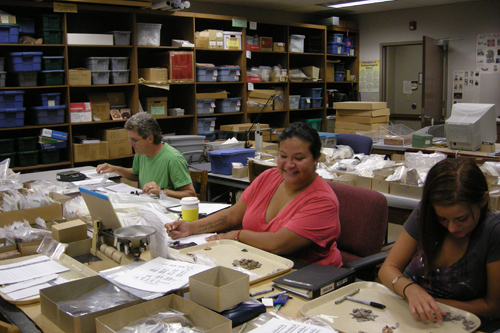3YE347 Artifact Analysis
The McClure site (3YE347) is one of the key Carden Bottoms sites that we are investigating as part of this project. Dr. Leslie (Skip) Stewart-Abernathy, Survey research station archeologist then located at Arkansas Tech University in Russellville, conducted preliminary excavations at the site in 1992–1994. Now located at the Survey’s Winthrop Rockefeller Institute (AAS-WRI) research station, Stewart-Abernathy supervised more extensive excavations at the site in 2009 as part of the Arkansas Archeological Survey/Arkansas Archeological Society annual training program. The 2009 excavations were based in part on the results of the archaeogeophysical survey conducted in February 2009 as part of this project. Basic cleaning, inventorying, and cataloging of the excavated materials has been completed at the AAS-WRI research station, but a thoroughgoing analysis of these materials is now under way at the Survey’s University of Arkansas-Fayetteville research station as part of this project. The collections, all carefully packed into 3-gallon storage containers, were transferred to the UAF research station in April 2010. The 1992–1994 collections fill 34 containers, while the materials excavated in 2009 fill 51 containers. Our initial procedures include sorting the artifacts first by material class (for example, stone raw material, ceramic paste/temper group, etc.), followed by identification of artifact type (stone projectile point, stone scraper, undecorated ceramic body sherd, decorated ceramic rim sherd, etc.), and finally, where possible, design/decoration type and/or variety (Nodena point, Barton Incised rim sherd, etc.). A series of measures, appropriate to each class of items, is also made. The materials are then re-packaged in acid-free, zip lock baggies for permanent storage. Inventory data are recorded onto our project coding forms using the Survey’s DELOS artifact classification nomenclature, and then keyed into a Microsoft Access database. We are currently transferring information in the Access database to a project database on our web server so that it can be made available to other project participants.
Jerry Hilliard, Leslie Walker, Aden Jenkins, and Jared Pebworth are doing most of this work. During the summer of 2010, they were assisted by University of Arkansas graduate student Rebecca Wiewel. Additional help was provided by Amber Perez and Lorianne Gillespie, American Indian students who were on campus for ten weeks during the summer of 2010 as part of an NSF-funded Research Experience for Undergraduates program. As of June, 2011, the database of information on these items consists of nearly 2,000 catalog entries. We expect to complete the processing of this material by September, 2011. |
||
 |

|
